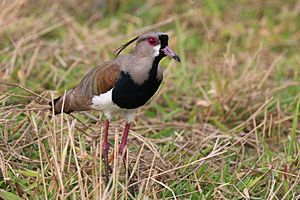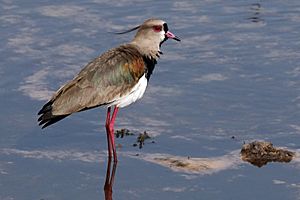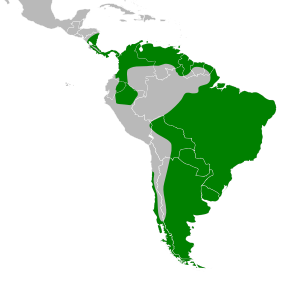Southern lapwing facts for kids
Quick facts for kids Southern lapwing |
|
|---|---|
 |
|
 |
|
| both V. c. lampronotus The Pantanal, Brazil |
|
| Conservation status | |
| Scientific classification | |
| Genus: |
Vanellus
|
| Species: |
chilensis
|
| Subspecies | |
|
3-4 (see text) |
|
 |
|
| Synonyms | |
|
Parra chilensis Molina, 1782 |
|
The southern lapwing (Vanellus chilensis) is a common bird found in South America. People call it different names, like quero-quero in Brazil, tero in Argentina and Uruguay, and queltehue in Chile. It is a type of wader, which means it often lives near water.
This bird lives all over South America. You won't find it in thick forests like the Amazon rainforest, high up in the Andes Mountains, or along the very dry western coast. It is very common in the La Plata Basin area. In recent years, it has also started spreading into Central America. It even reached the islands of Trinidad and Tobago.
Contents
What Does a Southern Lapwing Look Like?
The southern lapwing is the only lapwing in South America that has a crest on its head. It is about 32 to 38 centimeters (13 to 15 inches) long. It weighs around 250 to 425 grams (9 to 15 ounces).
Its back and upper parts are mostly brownish-grey. Its shoulders have a shiny bronze color. The head is very noticeable. It is mostly grey with a black forehead and a black patch on its throat and chest. A white line separates the black parts of its face from the grey head and crest. The rest of its belly and underside are white. Its eyes have a pink ring around them, and its legs and most of its beak are also pink.
Special Features
Southern lapwings have a unique defense tool. They have red, bony points, called spurs, under their wings. They use these spurs to scare away enemies and fight off birds of prey.
When the southern lapwing flies, it flaps its wings slowly. You can see a wide white bar on its wings. This bar separates the grey-brown color of its back from its black flight feathers. Its rump (the area above its tail) is white, and its tail is black. The bird makes a very loud and harsh sound, which sounds like keek-keek-keek.
Different Types of Southern Lapwings
There are three or four slightly different types, or subspecies, of southern lapwings. They look a little different around their heads and have slightly different calls. For example, the Vanellus chilensis fretensis from Patagonia is sometimes grouped with the main type, V. c. chilensis.
The northern types, V. c. cayennensis (from north of the Amazon River) and V. c. lampronotus (from south of the Amazon River), are sometimes thought of as a separate species. These northern birds have browner heads. The white band on their face is wider in the northernmost birds and narrower in the southern ones. This white band does not reach the center of their head crest.
Where Do Southern Lapwings Live?
Southern lapwings like to live near lakes and rivers. They also enjoy open grasslands. They have actually benefited from the increase in grasslands due to widespread cattle farming.
Sometimes, these birds nest near airports. This can be a problem because they might fly into the path of airplanes, which is a safety risk.
What Do They Eat?
Southern lapwings mainly eat insects, like grasshoppers. They also eat other small creatures without backbones, such as earthworms. Sometimes, they eat small fish. They hunt by running a bit, then stopping and waiting. They often hunt at night and in groups. In cities like Rio de Janeiro and Montevideo, you might even see them eating on brightly lit soccer fields during televised games!
Reproduction and Family Life
Southern lapwings often breed in groups. These groups usually include a pair of parents and one or two young birds from the previous year. They build their nests on grasslands or sometimes in fields that have been plowed.
Their nests are simple scrapes on the bare ground. The female lays 2 to 3 (sometimes 4) olive-brown eggs. The parents and their older young work together to protect the nest and the chicks. They are very loud and aggressive towards anyone who comes too close, including humans. They will make threats, call loudly, and fly low over intruders. After the breeding season, they spread out to wetlands and grasslands that get flooded during certain times of the year.
Gallery
-
Nest of V. c. lampronotus with small clutch
-
V. c. chilensis (Valdivia, Chile)
See also
 In Spanish: Tero para niños
In Spanish: Tero para niños













